Seth: A Life, All Play: Exhibit at the Art Gallery of Guelph, 358 Gordon Street, Guelph, ON – Sept. 12 to Dec. 15, 2019
I recently learned of the above-noted exhibit and as a result I drove at once from Stratford to Guelph.
I learned of the event through a tweet from the Guelph Arts Council @guelpharts.
I didn’t know where the Art Gallery of Guelph was but with Google Maps I found it.
It’s close to the student residences at the University of Guelph where we stayed for a while in a three-storey townhouse in Summer 2018:
Amsterdam’s bicycle culture stays in mind
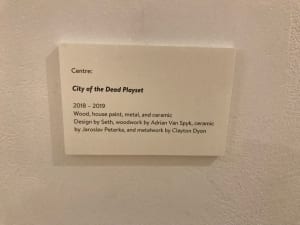
Source: Seth: A Life, All Play: Sept. 12 – Dec. 15, 2019 exhibit, Art Gallery of Guelph. 358 Gordon St., Guelph, ON
Click here to access a Sept. 29, 2019 Culture Days overview of Seth: A Life, All Play >
The description of the event at the above-noted link [I have broken the text into shorter paragraph] reads:
STORYTELLING
WRITING
LITERATURE
Featuring the work of graphic novelist and artist Seth, A Life, All Play focuses on the creative exploration that is integral to his storytelling, captured in a dense and lush installation that highlights his life in the studio as well as finished works – from sketchbooks, scrapbooks, and cardboard maquettes, to comic pages, ceramics and dioramas, including his model city Dominion.
Illustrating a process-oriented practice that is not much different from the way he made things as a child, the work on view encompasses the same childhood inspirations – comic books, toys and models, as well as DIY materials such as cardboard, poster paint, and glue.
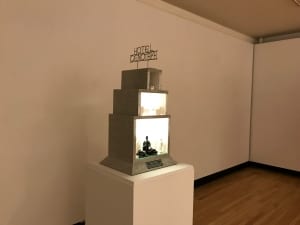
Source: Seth: A Life, All Play: Sept. 12 – Dec. 15, 2019 exhibit, Art Gallery of Guelph. 358 Gordon St., Guelph, ON
Reflecting a practice infused with genuine play, Seth has noted, “Sometimes this process leads to finished works, but sometimes it is just about the process itself – following a road that doesn’t always lead to a destination. Sometimes just walking down the road is the point.”
The cartoonist behind the comic book series Palookaville and the recent publication Clyde Fans, Seth’s comics have appeared in the New York Times Magazine, Best American Comics, and McSweeneys Quarterly.
His illustrations have also appeared in numerous publications including the cover of The New Yorker, The Walrus, and Canadian Notes & Queries.
Based in Guelph, Seth’s work has been the focus of solo exhibitions, including Dominion (multiple venues), Bannock, Beans and Black Tea (Confederation Centre Art Gallery, 2005), Seth (Macdonald Stewart Art Centre, 2006), Dominion-Beaver (RENDER/University of Waterloo, 2008), and Heading to Palookaville (Peel Art Museum and Archives, 2017).
He is the subject of the documentary Seth’s Dominion and has been involved in several animated adaptations of his comic books.
This event is free and will be accepting optional pay-what-you-may donations for admission.
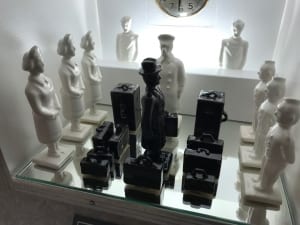
Source: Seth: A Life, All Play: Sept. 12 – Dec. 15, 2019 exhibit, Art Gallery of Guelph. 358 Gordon St., Guelph, ON
What the exhibit brings to mind
My visit to the exhibit brought to mind a previous post entitled:
The above-noted post features a drawing, which I admire, of Nikolai Yudenich.
I am also reminded of a post in which I discuss 1950s-era news photography photo retouching.

Source: Seth: A Life, All Play: Sept. 12 – Dec. 15, 2019 exhibit, Art Gallery of Guelph. 358 Gordon St., Guelph, ON
The post is entitled:
An excerpt from the above-noted post reads:
March 24, 1952 Toronto Star, page 1
March 24, 2019 Toronto Star, page 1
In future, if I get around to it, I will post all of the photos, from the newspaper pages featured at the post you are now reading.
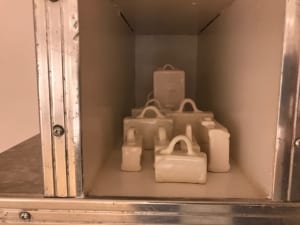
Source: Seth: A Life, All Play: Sept. 12 – Dec. 15, 2019 exhibit, Art Gallery of Guelph. 358 Gordon St., Guelph, ON
The current post includes a front-page photo from the March 24, 1952 Toronto Star that features a boy emptying water from a rubber boot while he stands in front of his storm-battered house in Long Branch. The photo displays a sign affixed to the house, which reads, “These premises are CONDEMNED.”
Buttonville: 36 consecutive poles town down by winds
Another photo (which I have not uploaded to the current post) features extensive retouching, so that the forms are clearly outlined. The caption reads: “ON DON MILLS Road, near Buttonville, a lineman checks wires attached to one of 36 consecutive poles which were pulled down by winds which reached velocity of 60 miles-per-hour. The storm penetrate 50 miles inland, caused two deaths, flooded town.”

Source: Seth: A Life, All Play: Sept. 12 – Dec. 15, 2019 exhibit, Art Gallery of Guelph. 358 Gordon St., Guelph, ON
I like the way such 1950s newspaper photos are retouched. The retouching is up-front and obvious. That to my eye gives them a retro look, which ties in (that is, in my own mind, at least) with the image manipulation (via silk screening) that underpins Andy Warhol’s early work. Such image manipulation is also a key element in the Pop Art movement that emerged during the 1950s.
In turn, the simplification of imagery (and conceptual and literal reframing) that is inherent in Pop Art also manifests itself in work by street artists such as Banksy. Such simplification is also inherent in propaganda art on behalf of a wide range of ideologies. Many things come to mind, when a person observes 1950s photo retouching.
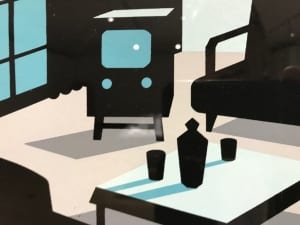
Source: Seth: A Life, All Play: Sept. 12 – Dec. 15, 2019 exhibit, Art Gallery of Guelph. 358 Gordon St., Guelph, ON
The Very Rev. Dr. Malcolm A. Campbell
I am also reminded about a post about an official, at the Protestant School Board of Greater Montreal, after whom the high school that I attended in the early 1960s is named:
Gangster genre
The Seth exhibit also brings to mind the gangster genre of literature; a recent post regarding the genre is entitled:
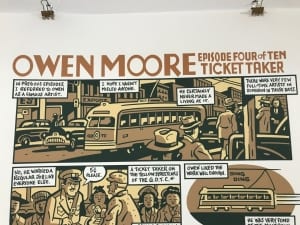
Source: Seth: A Life, All Play: Sept. 12 – Dec. 15, 2019 exhibit, Art Gallery of Guelph. 358 Gordon St., Guelph, ON
An excerpt from the above-noted post reads:
Recently I’ve been reading studies by Geert Mak and James C. Scott, which has prompted me to think about the manner in which stories about history – including about current history – are presented and preserved.
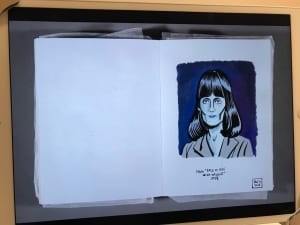
Source: Seth: A Life, All Play: Sept. 12 – Dec. 15, 2019 exhibit, Art Gallery of Guelph. 358 Gordon St., Guelph, ON
An excerpt from article by Geert Mak at his website, entitled “2017 as a year of truth,” reads:
The sociologist Karl Erikson described already in the seventies, the phenomenon of ‘collective trauma’, an event – the closure of a mine, a reorganization, the end of the classic village and farmers life – which, apart from all economic and material consequences, meant a deep break with relationships and routines that had defined life there for generations. Without these social anchors people struggle to find again meaning and purpose in their lives, they feel often totally disoriented and disconnected, and their deepest feelings can often be translated in four words: “Please, let’s go home.” “Let’s go home, back to the good old days.” And they follow every leader who promises to bring them home again. But there’s no home anymore.’
There are many possible frames to choose from – many choices are available to us – regarding how we position a given assortment of data related to events, that have occurred in the past.
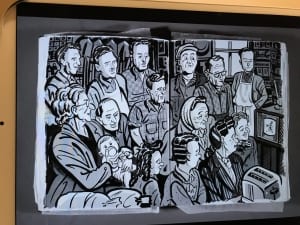
Source: Seth: A Life, All Play: Sept. 12 – Dec. 15, 2019 exhibit, Art Gallery of Guelph. 358 Gordon St., Guelph, ON
As well, access to the past requires a person to imagine it – to picture history, in her or his mind.
Another post that comes to mind is entitled:
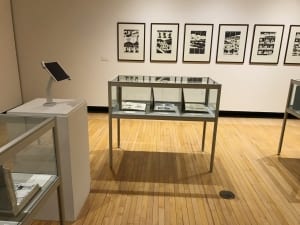
Source: Seth: A Life, All Play: Sept. 12 – Dec. 15, 2019 exhibit, Art Gallery of Guelph. 358 Gordon St., Guelph, ON
An excerpt reads:
At a previous post, at which I outline research by James C. Scott, I refer to a study entitled Comparative Political Corruption (1972).
James C. Scott is an anthropologist and political scientist.
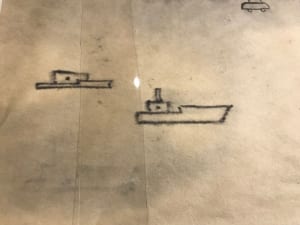
Source: Seth: A Life, All Play: Sept. 12 – Dec. 15, 2019 exhibit, Art Gallery of Guelph. 358 Gordon St., Guelph, ON
A description at Google Scholar (in Scott’s own words) of the above-noted study reads:
The perspective of this book is that corruption, like violence, must be understood as a regular, repetitive, integral part of the operation of most political systems. In practice, this simply means that an analysis of who in a society gets what, when, where, and how that relies exclusively upon an examination of those political acts open to public view would seldom provide an accurate picture of political reality. Recurring acts of violence and corruption are thus more successfully analyzed as normal channels of political activity than as cases of deviant pathology requiring incarceration and/or moral instruction for the perpetrator (s). Just as social banditry and piracy must be viewed as integral parts of many agrarian and maritime economies, so, for example, must vote-buying and “rake-offs” be seen as an integral part of United States urban politics at the turn of the twentieth century. Far from being pathological, patterns of corruption and violence may actually represent channels of political demands without which formal societal arrangements could scarcely survive.
In keeping with this perspective, I have consistently tried to show how patterns of access and exclusion in the formal political apparatus help determine which groups will most likely resort to corruption or violence.
Since corruption is a violation of certain rules, the amount and nature of corruption is, in part, determined by those rules. If the rules permit large campaign contributions, they often simply institutionalize a transaction between wealth and power that occurs illegally under a more restrictive set of rules. Given the importance of the existing set of rules to any examination of corruption, I have …
The online quote trails off at that point.

ive starred at tghe wall many of occassions, and then it dawns on me more or less, how off the wall, the amazing list of contributors, Guelph has yet another victory in those who have actually influenced the world. astonishing how deprived I, myself to make a relevant notation relevant enough known too.
Good to read your comment Jennifer. Your comment has prompted me to re-visit this post. I’m really pleased I attended the exhibit.